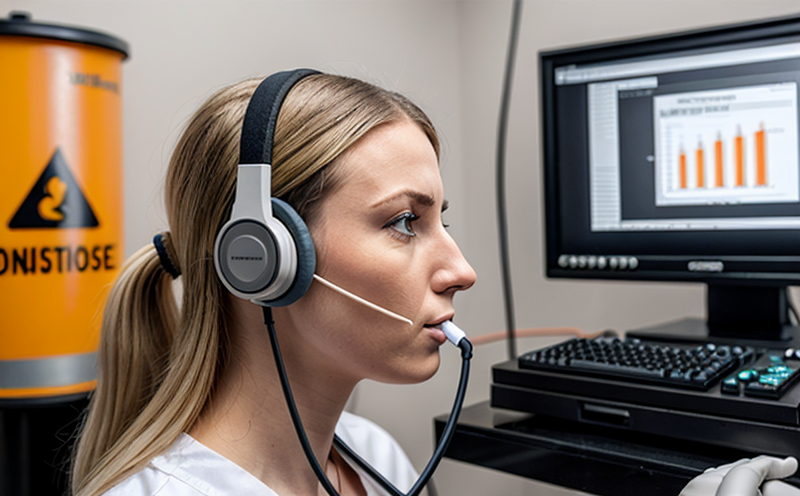WHO Occupational Noise Exposure and Hearing Risk Assessment Testing
The World Health Organization (WHO) has established guidelines to protect workers from occupational noise exposure and mitigate hearing loss risks. This service provides comprehensive testing to assess the risk of hearing impairment due to occupational noise levels, ensuring compliance with WHO recommendations.
Occupational noise-induced hearing loss is a significant global health issue affecting millions of workers worldwide. According to the World Health Organization, approximately 26 million people in the U.S. alone are exposed to hazardous sound levels at work. This service plays a crucial role in minimizing such risks by offering precise and reliable testing methods.
The testing process involves measuring ambient noise levels using calibrated sound level meters and dosimeters worn by workers. Dosimeters provide personal noise exposure data, which is critical for assessing individual risk factors. The WHO recommends that daily weighted sound exposure levels (Leq,8h) should not exceed 85 dB(A) to prevent hearing damage.
The testing methodology adheres to the following international standards: ISO 1999-2, which specifies methods for measuring occupational noise exposure; and WHO guidelines, which emphasize the importance of reducing noise levels below the recommended threshold. By using these standardized protocols, we ensure accurate and consistent results that are widely recognized in the global health community.
Our testing service is designed to meet the needs of various stakeholders including quality managers, compliance officers, R&D engineers, and procurement specialists. Quality managers can use this data to identify high-risk areas within their facilities, while compliance officers ensure adherence to regulatory requirements. R&D engineers benefit from understanding noise sources that can be mitigated through design improvements. Procurement teams gain insights into selecting appropriate personal protective equipment (PPE) such as earplugs and earmuffs.
The testing process begins with a site assessment to identify potential noise sources and workstations where employees spend significant time. Dosimeters are then distributed to workers who will wear them during their typical shifts. At the end of each shift, dosimeters are collected for analysis. Simultaneously, sound level meters are used to measure ambient noise levels at various locations throughout the facility.
Post-testing, detailed reports are generated summarizing the findings and comparing them against WHO guidelines. If excessive noise levels are detected, actionable recommendations are provided to reduce exposure. These might include implementing engineering controls like sound barriers or administrative measures such as reducing working hours in noisy areas.
The importance of this testing cannot be overstated. Early detection of high-risk areas allows for timely interventions that can prevent long-term hearing damage. By adhering to WHO recommendations, organizations not only protect their employees' health but also enhance productivity and reduce absenteeism associated with occupational hearing loss.
Applied Standards
| Standard | Description |
|---|---|
| ISO 1999-2:2018 | This standard specifies methods for measuring occupational noise exposure and provides guidance on how to interpret the results. |
| WHO Guidelines, Hearing Loss Prevention | The World Health Organization's guidelines outline safe levels of noise exposure to prevent hearing damage in the workplace. |
Benefits
This service offers numerous benefits to organizations committed to protecting their workforce. Firstly, it ensures compliance with international standards and regulatory requirements, thereby avoiding potential legal issues. Secondly, by identifying high-risk areas early on, companies can implement effective mitigation strategies before significant damage occurs.
Moreover, this testing enhances overall employee wellbeing by promoting a safer working environment free from excessive noise pollution. Reduced absenteeism due to occupational hearing loss translates into increased productivity and lower operational costs. Lastly, organizations demonstrating commitment to worker health gain a competitive edge in the market, fostering positive brand reputation.
Industry Applications
| Industry Sector | Specific Application |
|---|---|
| Agriculture | Evaluating noise levels in tractors and farm machinery. |
| Mining | Assessing risks associated with drilling operations. |
| Construction | Measuring noise generated by heavy equipment like bulldozers and jackhammers. |
| Manufacturing | Evaluating assembly lines and factory floors for excessive noise levels. |
| Healthcare | Determining noise exposure in emergency rooms and operating theatres. |
| Transportation | Evaluating noise levels in train depots, airports, and bus terminals. |





